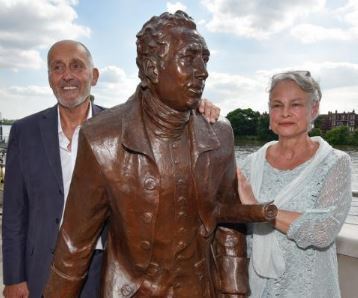Statue of Capability Brown Unveiled on Hammersmith's Riverside
New permanent memorial for 18th century 'greatest landscape gardener'
Capability Brown, "England's greatest landscape gardener" has returned to Hammersmith's riverside - 250 years after leaving.

The statue with sculptor Laury Dizengremel and the Hammersmith Society's Richard Jackson
A bronze statue of the historic figure has been unveiled in Distillery Wharf, at the foot of Chancellor's Road.
The statue of Lancelot "‘Capability" Brown, the first ever created of the 18th century landscape designer, has been created to commemorate the 300th anniversary of his birth.
Sculpted by Laury Dizengremel and cast at Ai Wei-Wei’s foundry in Chengdu, it has been shipped from China and up till now has been displayed at the Trentham Estate in Staffordshire.
Now, following a successful crowdfunding campaign championed by the Hammersmith Society's Richard Jackson, the statue has been brought in Hammersmith, where it will stand as a permanent legacy.
"Capability Brown was without challenge England's greatest landscape designer," said Richard.
"Following the national celebrations for the tercentenary of his birth in 2016, the Hammersmith Society agreed to support a campaign to commission a statue to be sited by the river in Hammersmith, close to where he lived with his family, for thirteen years.
"It was during this time that he designed his greatest landscapes including Blenheim, Petworth, Chatsworth, Burghley and Alnwick."
In 1751, Capability Brown moved to Hammersmith Mall beside the Thames with his wife, Bridget and their young family, and lived there for 13 years until being appointed Royal Gardener by George III with a grace and favour house at Hampton Court Palace.
Hammersmith proved to be an ideal choice, with easy access to his clients’ London homes, the large tree nurseries at Brompton, and the local pool of skilled labour whose services he could draw upon.
During his years in Hammersmith he undertook many of his great commissions, including Longleat, Blenheim and Chatsworth as well as 27 London gardens. Nearly all of them have since been either built over, including the Peterborough Estate in Fulham or substantially altered, including Kew. Syon Park is now the best preserved of his London landscapes.
Brown died in 1783 and his home beside the Thames has long since been demolished.

Guests at the unveiling ceremony on Wednesday 24 May
May 26, 2017
May 26, 2017
May 11, 2017
Related links
|